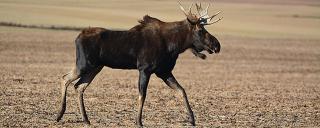
Moose
| Scientific Name | Alces alces |
|---|---|
| General Description | Averages about 62 inches and 64 inches at the shoulder for cows and bulls, respectively. Bulls average 950 pounds (range 550-1,300 pounds); cows average 880 pounds (range 600-1,130 pounds). Coat black, legs dark brown to gray. Large nose, with overhanging snout, pendent “bell” on throat. Antlers on males only. Main beam extends out and back, with small tines protruding from the edges of each palm. |
Tracks |
Moose tracks: Front track slightly larger Front–4-1/2" - 7" L, 3-3/4" - 6" W. Rear–4" - 6-1/2" L, 3-1/2" - 4-1/2". W Walking stride: 28" - 44". |
| Habitat | Aspen and boreal forests with lakes and wetlands. Moose have extended their range into the prairie where forested river bottoms and tree rows provide browse. |
| Food | Moose browse on a variety of willow species, aspen, birch and green ash. They will also feed on aquatic plants such as pond weed and moist meadow species like horsetail and lichens. In agricultural areas, moose will also eat sunflowers and corn. |
| Range | Found primarily in the Turtle Mountains and along forested rivers in the northern one-third of North Dakota. Scattered family units frequently found along the Canadian border and eastern third of the state. |
| Mating | Breeding peaks in late September and early October with bulls tending individual cows, and at times defending harems. No permanent pair bonds. Gestation averages about 231 days (range 216-264 days). |
| Young | One to two calves born mid-May to mid-June, weighing about 34 pounds. Coat dark brown. |
| Habits | Most active at dawn and dusk. Cows typically accompanied by calves. Outside of the breeding season, males alone or in small bachelor groups. |
| Fun Facts | Moose are the largest member of the deer family. There are probably more moose in North Dakota today than when Lewis and Clark traveled through the state in 1804-06. |
Living with Moose in North Dakota
Moose are native to North Dakota, but they disappeared following settlement in the late 1800s and early 1900s and did not start reappearing until the 1950s. When moose populations began rebuilding in North Dakota, they flourished in typical moose habitat such as forested areas with rivers, streams and lakes in the Pembina River Gorge and Turtle Mountains.
But even in the early days of moose returning to North Dakota, some animals were observed taking up residence in areas that were not traditional moose habitat. That phenomenon has continued to this day, with moose populations established in agricultural river bottom landscapes all across the northern tier of the state, from Walhalla to Williston.
As such, moose sightings are not uncommon anywhere in the state, and as the population has expanded, individual moose on occasion have wandered into towns and cities where they warrant real safety concerns.
Moose and Crops
Moose are mostly browsers and do not typically eat hay or other foods meant for cattle. But they are adaptable and at times will eat standing crops such as sunflowers or corn. While they are usually alone or in small groups such as a cow and calves, in the spring and summer moose need about 50 to 60 pounds of food per day. If they hang around in one place for an extended period, they can cause crop damage.
In such cases, the Game and Fish Department may be able to direct licensed hunters to landowners experiencing crop damage. The Department’s private lands program may also be able to provide technical assistance to landowners to help minimize crop depredation, or work with landowners to develop wildlife food plots specifically intended for depredation purposes. To find out more about crop damage prevention measures, contact the Game and Fish Department at 701-328-6300.
Feeding Moose
When moose wander into farm yards or urban areas during winter, it might be tempting to provide a hand-out if these animals look like they are struggling. But feeding moose, or any wild animal for that matter, almost always does more harm than good. Moose fed by humans tend to lose their healthy fear of man, and they may hastily approach the next unsuspecting person they see – or even attack people who don’t have food to offer.
If a moose in your neighborhood is fed, the chances it will charge people, especially children, increase greatly. It is often necessary for wildlife officers to kill moose that present a heightened public safety threat.
Therefore, by purposely feeding moose, people can potentially contribute to the animal’s death.
Moose-Vehicle Collisions
In parts of North Dakota, moose are common enough that collisions with vehicles sometimes occur. When driving in moose country, especially in winter, slow down. If a moose moves into the path of your vehicle, stop as quickly as you safely can, but don’t swerve. Swerving may cause you to lose control of your vehicle.
The Bottom Line
Most people in North Dakota enjoy seeing moose and it is a good thing that their population is expanding. It’s important to remember that they are wild animals and should only be observed from a distance.

